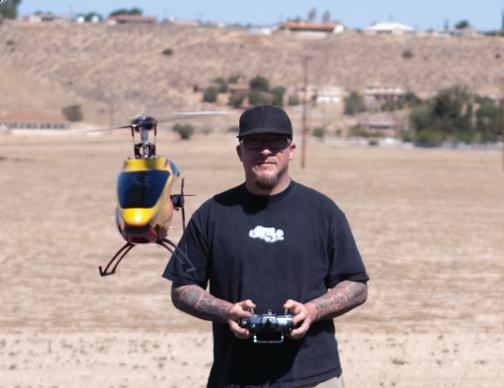If you have been flying helicopters for a while now, you may be advancing into faster forward flight. One of the first aerobatic maneuvers I learned a long time ago was a straight forward roll. When you practice any maneuver for the first time, your first attempts will not always be the prettiest. However, with practice and good collective management, you will easily perfect this quite simple move. As with any new move, allow for lots of room for recovery. Being a few mistakes high is always good practice when learning new flight tricks.

- ENTER From forward flight in a straight and slightly nose-down position, this will be the start of your maneuver.
- 1 With slight right aileron input and decreasing your pitch to make the helicopter roll on its axis, keep this input to roll into a sideways first point of your roll.
- 2 (when inverted): Holding your right aileron input once the heli is inverted, you will now slightly increase negative pitch to maintain your roll so the helicopter does not go up or down in altitude.
- 3 (helicopter belly in) While maintaining your right aileron input, you will now increase or decrease your pitch with the skids pointing to you to keep the heli rolling still on its axis.
- EXIT: Return to straight and level flight by releasing aileron input and slightly increasing pitch to fly out in the same position and heading from which you entered this maneuver.
This maneuver is easily accomplished with any collective pitch helicopter you are currently flying. As for equipment requirements, if your helicopter is set up for aerobatics, has good cyclic response, and has a mechanical setup that’s on the money, you should have no trouble at all with this move. Anything from a small, micro helicopter to a larger scale model can be used but, like most models, the bigger the better in terms of ease and stability. For the larger 450+ models, I recommend stiffer carbon-fiber blades due to more stress being put on the rotor blades.
Flying a flybarless helicopter will make this maneuver a lot easier, but you can also easily accomplish it with a properly set up, flybar-equipped heli. A flybarless model will be more prone to correcting the swashplate during the maneuver, while a flybar-equipped model will need the pilot to compensate for corrections. As with any type of maneuver, a well set up model is key to success with this or any maneuver you attempt.
GETTING PREPARED
As you advance your skills and are comfortable with faster forward flight, get a feel for how your particular model rolls on its axis. Make sure your model is in idle-up mode, and start by doing a stationary roll from a hovering position to get a feel for how much cyclic pitch correction is needed as you roll the helicopter right or left. As you start to roll the model over to get it upside down, slightly decrease pitch while it is upside down and increase it slightly as the model returns to right side up. Keep practicing this until you can roll the helicopter on its axis.
IT’S GO TIME!

As with all new maneuvers, start high. Then as your confidence builds, bring the helicopter down and perform closer to the deck.
Now that you are comfortable with your stationary rolls, you can start in a forward flight motion. Flying across the field, get a good feel for straight and level flight by flying both up and downwind over the runway at altitude. Start the roll the same way you did when the heli was stationary _ by adding aileron. Control the pitch as the helicopter rotates and input elevator corrections to keep the heli flying in a straightforward motion during the maneuver.
As the model flies forward, add aileron and keep the helicopter on its axis by adding a bitof down-elevator to control the nose as the helicopter is upside down, and add up-elevator as it rolls back to upright. If, like me, you fly fixed-wing aircraft, you can relate—when a plane is upside down, some down-elevator is needed to keep the nose up. The main difference is to add pitch control to keep the heli on its axis.
CONCLUSION
Get out there and practice this maneuver! As you start to excel, you will find yourself practicing more variations like multiple stationary rolls, which require the same corrections as a straightforward flight roll but in a stationary position. I have found that doing rolls will really get both of your sticks moving and will help with good cyclic control. As you continue to practice doing multiple rolls in fast forward flight, you can show finesse and good control of your model. Next thing you know, you will start adding rudder corrections and find yourself attempting rolling circles, but just take it one roll at a time for now. Get out to the field and have fun!























